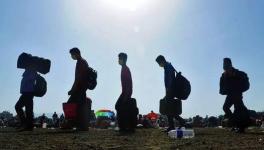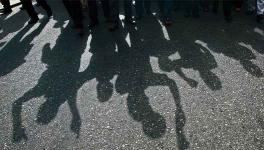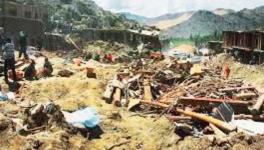Odisha Climate Migrants: In Satabhaya, Resettled Women Left to Fend for Themselves
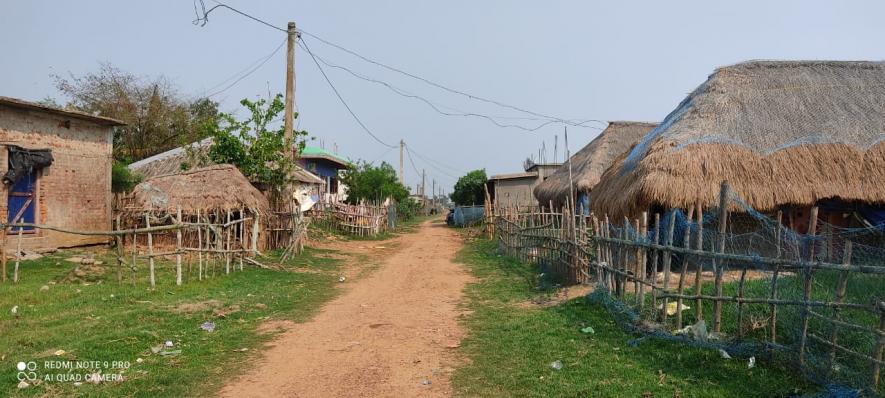
Bagapatia Resettlement colony, where most houses are half constructed with thatched roofs. The money received through PMAY is insufficient for building on marshy land.
One summer noon in April, Smita Das, 34, after finishing her household work, was rushing to a meeting called “Palli ru Prasasan” held by the local administration near her resettlement colony Bagapatia, in Odisha’s Kendrapara district. The programme was held to discuss various government schemes which villagers can avail. Smita was keen to get financial support through Odisha Livelihood Mission (OLM) to purchase goats so that her earnings could be spent on additional family expenditures.
“There is no livelihood option here. Since we relocated to Bagapatia, all the villagers have struggled to make ends meet. Men migrated to Kerala to work in plywood factories while women and children struggled to survive. If I get some financial support to purchase goats, the earnings would be spent towards children’s education, health, food and other household needs,” a hopeful Smita told this writer.
Smita is among the 100 applicants applying for various government schemes to meet their daily needs. Their demands range from housing to Public Distribution System (PDS) ration cards, livelihood schemes, old age pensions, and other benefits.
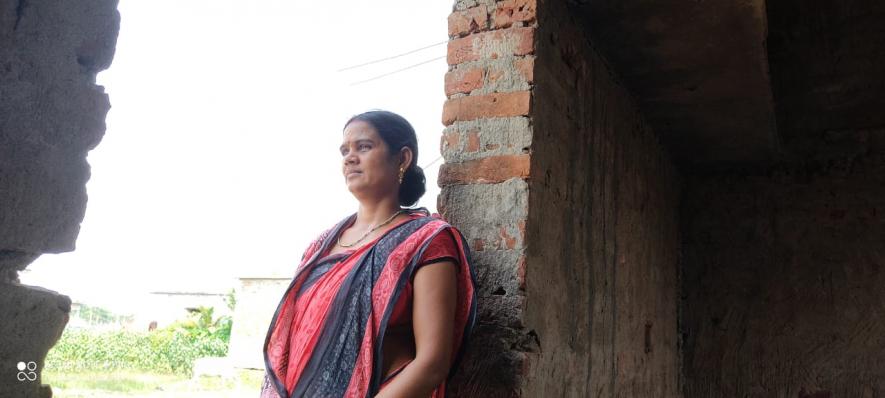
Smita at her half-constructed house under the PMAY scheme
“Here we are, struggling for everything. Our husbands send Rs 3,000 to 4,000 monthly, depending on their income. That meagre money will be spent on food, clothes, health and education. After spending, nothing is left in hand. This goat rearing may help to meet that requirement, and I can save something for the future,” said Smita.
Struggling to get RoR
According to a report released by the Forest, Environment and Climate Change Department, government of Odisha, at least 36.9% area along the Odisha coast is facing sea erosion.
Satabhaya Panchayat under Rajnagar block of Kendrapara district is one of the worst hit. As the name suggests, barely one village is left in a once cluster of seven villages, with six villages swallowed by the sea. Tehsil record shows the old seven villages were Benupur, Mohanpur, Govindpur, Sana Sahipur, Bada Gahirmatha, Balisahi and Rabindrapalli.
In 1971, when a cyclonic storm struck the Odisha coast, the people of these villages developed a fear of sea erosion. They moved inland and formed new villages, such as Satabhaya, Kanhupur, Magarakanda and Barahipur. Among these, Satabhaya was the gram panchayat for all administrative activities.
“But the sea erosion didn’t stop. It continued to grab our cropland, houses, grazing fields, etc. This forced some villagers to move to other places,” said Uttama Prusty, 70, earlier a resident of Barahipur village and now relocated to Bagapatia.
After the Super Cyclone in 1999, almost all the villagers moved to different places in Rajnagar block for the safety of their family members. Smita recalled she was then 12 years old but can still remember the fierce sounds of the ingression of sea waves, especially during the cyclone days.
“We couldn’t even sleep the whole night. We used to live in fear that the sea would ingress within a few minutes,” said Smita, adding her parents left everything behind in the village and started settling at Okilapal with others.
To meet their financial needs, two of Smita’s brothers left their studies and went to Kerala to work in plywood factories with their father. Her education was also stopped, and she was married off when she turned 16. “Most of us had to leave our studies and get married early. But the plight is such that even after marriage, we must struggle alone as our husbands migrated to Kerala to earn a living,” said Smita, who lives in Bagapatia with her two schoolchildren. In Bagapatia, around 80 % of men have migrated to Kerala to earn a living.
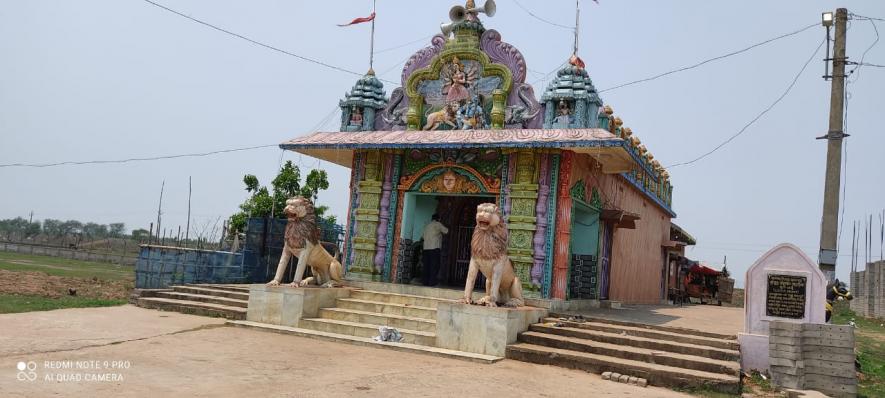
Panchubarahi temple shifted to Bagapatia from Satabhaya
After five years of continuous protest, the state government woke up to sea erosion realities and decided to relocate villagers. The government planned to rehabilitate villagers in Bagapatia, but it was to a 100-acre marshy land where several prawn farms were operated. After land acquisition got over, villagers settled here with assistance from the government.
People of these four villages are now adjusted in 19 lanes, each occupying four-five lanes in the resettlement colony. As per the information, 571 families reside in these 19 lanes. Out of them, 148 families received allotment letters but are waiting to get possession, while 99 families were identified to get plots but neither received any allotment letter nor possession. All of them are struggling to get land pattas or Records of Rights.
During this writer’s discussion with families, it was found that people were entirely left out of the rehabilitation programme, forcing them to struggle at every level.
“This creates a problem for all the residents to apply for different schemes. If you apply for any government scheme, you need residence proof, but we don’t have pattas in our names,” said Shantilata Biswal, 46, a resident of Bagapatia.
Chulbuli Parida, 23, is among those whose family is left out of the rehabilitation programme. “Since my marriage, I have not added to my in-law’s ration card. My father-in-law has not yet received a patta in the resettlement colony, so we are deprived of financial support in the housing scheme,” said Chulbuli, whose family is settled in Mahima Nagar, a few kilometres away from Bagapatia.
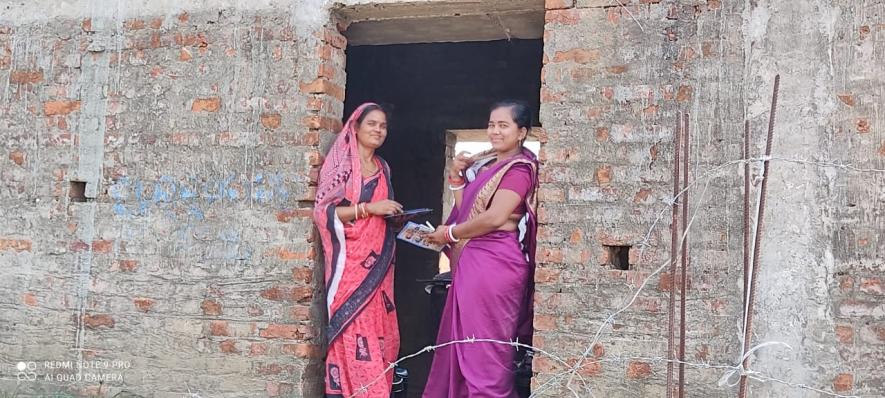
Chulbuli Parida and Smita Das are standing at the entrance of Smita’s half-constructed house
Shyam Sunder Lenka, Head Master of Government UG (upper graded) High School, Panchubarahi, Satabhaya, said, “Though villagers are allotted land, the 10 decimal land patta has not yet been transferred to their names. Had the Census been done in 2021, it would have helped them enrol in land records. You don't belong to that place when you don’t have a patta.”
No livelihood option
In Satabhaya, farming and fishing were two livelihood options that the villagers depended on. Besides, they collected honey, and reared cows, buffalo, hens and goats to meet their daily food requirements and earn. Since they left Satabhaya, everything has gone -- farmland, fishing and livestock.
“In Bagapatia, we are given only 10 decimal land to construct houses but no farmland for cultivation. There is no grassland for grazing cows and goats,” said Shantilata, adding that in the entire resettlement colony, there are only women and their children, as all men have migrated to Kerala for earning.
Boys aged 14 and 15 have started migrating to Kerala with their fathers and uncles to work in factories. Smita said her husband went to Kerala when he was 15-years old and since then, he has been working there, and she is alone taking care of the family in his absence.
Those who have not migrated, work in the Rajnagar block as daily wage labourers, and others go to Satabhaya to catch fish. “Around 50 families settled in the colony daily walk 10 km to Satabhaya to catch fish. If they do not do this, what will they eat?” asked Shanti.
The women said in Satabhaya there was no electricity, health care facility and higher education. If any woman had complications during childbirth, she had to be brought in a sling to Community Health Centres (CHC) in Rajnagar Block. Children had no higher education facility, so they were kept in hostels or relatives' houses.
“Men migrated to Kerala due to a lack of livelihood options. These days young women are also migrating to Kerala, Bengaluru and Hyderabad to work in garment factories,” said Sabita Rout, 46, a resident of lane number 8 in Bagapatia, adding that because of lack of pattas, women were not able to get loans to start a business.
Resentment over resettlement
When the government planned to rehabilitate villagers of Satabhaya Panchayat to protect them from regular sea erosion threats, initially Sunei Rupei, a place near Rajnagar block, was selected. Later, a 100-acre plot of marshy land was acquired in Bagapatia to rehabilitate them. According to a government report, each resettled family was provided plots measuring just over 400 square meters and financial assistance of Rs 1.35 lakh to construct their houses. It also says the government has built a high school, a cyclone shelter and a market complex in the colony and provided it with piped drinking water. But, this didn’t find any market complex or piped drinking water facility in the colony.
“When we came to build up our house, the land was marshy, we filled up the land with truck-loaded soil before construction of the house. The government provided us Rs 1.35 lakh to Rs 1.65 lakh for construction of houses, but a major portion was spent on filling the land,” said Geetanjali Prusty, 43, adding, “Our plight didn’t end. The land was used for prawn cultivation, and they used various chemicals. Now, we are suffering from skin diseases.” Most of the women sitting with her agreed in unison.
Talking about schools, the headmaster said, “the school shifted in 2017 to Bagapatia, and has been dealing with lack of infrastructure. The upgraded high school has seven rooms, including an office room and kitchen. The primary school runs in a cyclone shelter, while higher classes are adjusted in two classrooms. Besides, the school doesn’t have an all-weather road, so during monsoon, the attendance of students falls. These days parents are keen to send their children to school, but the school has no proper infrastructure.”
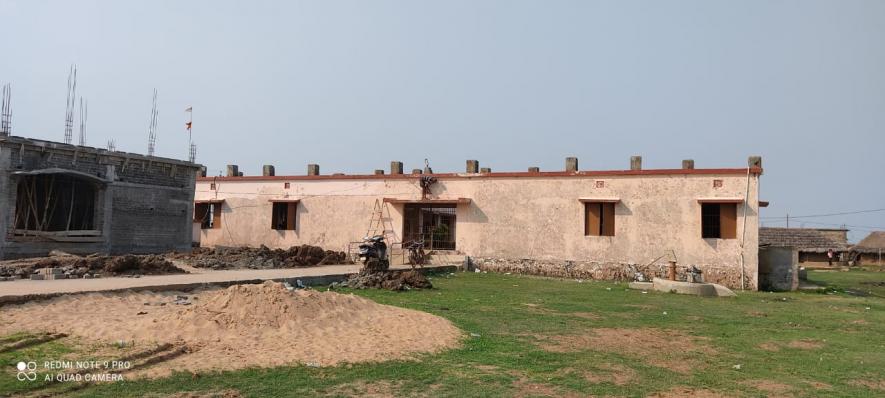
Panchubarahi UG High School in Bagapatia, the school shifted in 2017, still struggling with a lack of infrastructure
Interventions from NGO
The Regional Centre for Development Cooperation (RCDC), a non-profit organisation working in the field of climate change and disaster risk reduction, has started Project Pragati to ensure rehabilitation, skill building, livelihoods and resilience of climate-displaced people of Bagapatia. Women were encouraged to form Self-Help Groups (SHGs) to initiate livelihood options like backyard poultry, tailoring and kitchen gardens.
“During our field survey, we found that income and food diversity has reduced because of the lack of livelihood opportunities. At least in Satabhaya, they got protein and other nutritious food from farming and fishing. This kitchen garden and backyard poultry will help them to fill that gap,” said Kailash Das, Executive Director, RCDC.
He added, “Young men and women migrate to Kerala, Hyderabad, and Bengaluru to work in plywood and garment factories. During the survey, it was found few migrants returned from their workplaces. We addressed their problems, did counselling and mobilised them to go for alternate livelihoods. As young women who couldn’t cope in garment factories and returned, we provided them skill training in tailoring, and few of them have started their tailoring units”.
The RCDC team also initiated the registration of migrants under the Directorate of Labour, government of Odisha. Besides, the team has also planned to create local employment opportunities for those migrants by linking them with government schemes.
When asked how women manage financial needs during emergencies, almost all said they borrow money from microfinance. There are about 6-7 microfinance companies operating in their colony, and whenever there is any need, they take loans with huge interest. “We repay them from the money sent by our husbands, but most of the time, we repay again by taking another loan,” said Shantilata adding, “If we start backyard poultry, it will help us during an emergency.”
“Here the government has resettled us, but there is no livelihood opportunity, which forces our husbands to migrate to far-off places. My husband comes once or twice a year, I have to manage everything in his absence. If we had farmland for cultivation, he wouldn’t have migrated. At least we would have lived together,” said Smita.
The writer is an independent journalist based in Odisha.
Get the latest reports & analysis with people's perspective on Protests, movements & deep analytical videos, discussions of the current affairs in your Telegram app. Subscribe to NewsClick's Telegram channel & get Real-Time updates on stories, as they get published on our website.









